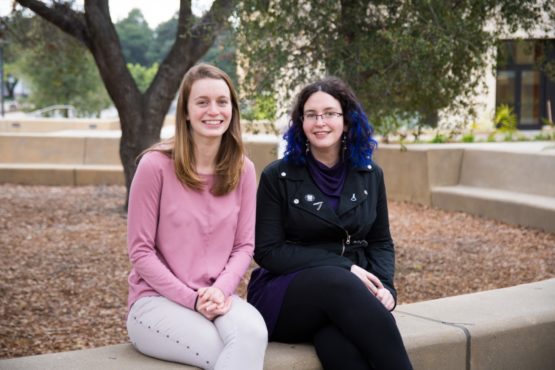Chemistry students provide space for underrepresented groups in science
Two Stanford graduate students are helping underrepresented students in the Chemistry Department chat with faculty they relate to over breakfast. Their group aims to establish a community and facilitate conversations about diversity in science.
Breakfast conversations have taken a new shape in Stanford’s Chemistry Department, thanks to the efforts of two graduate students: Jen Marrero Hope and Natalie Geise, now fourth-year students in the department’s PhD program.
The duo began the Chemistry Association for the Interests of Minority Students, ChemAIMS for short, when they saw a gap in support for underrepresented groups in chemistry and decided to set up a group on their own. The group gives women, LGBTQ+ and underrepresented minority students a place to find support and organizes opportunities to interact with visiting faculty.

Chemistry graduate students Natalie Geise, left, and Jen Marrero Hope founded ChemAIM as a way of creating a community for women and minorities in chemistry. (Image credit: Binhong Lin)
The founders said chemistry graduate students typically bond with their cohort as they take classes and teach in their first year. But then they withdraw to their respective labs – which may be less diverse – for the next few years to do experiments and complete their degrees.
“It’s much more likely that you would be the only woman or only Latinx in your lab or that you see in your day-to-day life,” Geise said. “That can be really hard and graduate school is already pretty isolating, so it’s important to have a community.”
A friend of Hope’s at Caltech coordinated student breakfasts with women invited to give department seminars. Based on the success of that program, Hope started a similar group at Stanford, boosted by department funding for food. “Since then it has expanded with the goal of hosting speakers from a broader range of underrepresented backgrounds,” Hope said.
With the breakfasts, Hope and Geise sought to create a space for students to interact with speakers they have something in common with. Students have the chance to ask questions they might not feel comfortable asking in front of the entire department or to discuss the struggles of being an underrepresented person in science.
“When the department invites speakers who look like us, getting a piece of their time to talk with them and say ‘Hey, I don’t see you guys very often. How did you do it?’ felt really important,” Hope said.
Promoting inclusion
Hope and Geise learned the ins and outs of planning department events when they joined the Chemistry Department’s Graduate Student Affairs Committee in their first year at Stanford. They discovered how to find funds and get people on board for new events. So, when Hope and Geise launched ChemAIMS in 2017, they had at least some idea of what to do.
The name, they said, was “shamelessly stolen” from the biomedical diversity group on campus (with permission), called BioAIMS. While BioAIMS supports students in the biosciences and medical school, which encompasses a large portion of Stanford’s campus, ChemAIMS focuses on helping students whose work might not be related to biology. To date, 91 trainees – which includes graduate students and some post-doctoral researchers – are on their mailing list.
“It’s cool to try and spread the love so that people in other sciences also have somewhere to go,” Hope said.
Though ChemAIMS started with breakfasts, it has expanded to include a research discussion group spearheaded by Geise and a community-driven book club, which just finished reading Bad Blood by John Carreyou. And this spring, ChemAIMS will host their first student-invited seminar speaker, Miriam Bowring from Reed College in Portland, Oregon. Bowring will give a talk on her research but will also focus on diversity in science.
“It’s important to have the smaller groups where we are the focus,” Hope said. “It’s also important to have a larger, inviting community and say, ‘Hey, you also need to be thinking about this.’”
This year Hope and Geise were invited to speak about ChemAIMS at student orientation in the fall. And they will present a poster at the department’s recruiting events.
“We’d like to see more students who feel that they’d be welcome and that this is an environment where we do care about these issues,” Geise said.
Balancing act
Despite their success, Hope and Geise are not primarily focused on advocacy – they are graduate students striving to earn their doctorates. That can make it hard to find time for ChemAIMS, but both see it as an important part of their Stanford experience.
“I know logically that being at the bench and working all the time is not efficient,” Geise said. She added that her research is structured in a way that keeps her busy during some periods and more relaxed in others, which makes it easier for her take time away to organize ChemAIMS events.
“This kind of work is what keeps me sane in graduate school,” Hope said. “Because experiments don’t work all the time and it’s good to remember that there are other ways that I’m making an impact on my community and the department.”
